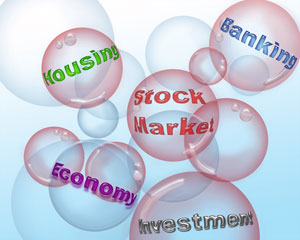Of Market Bubbles and Busts: Learn to Spot Trouble in the Making
 Recent stock market conditions in China present a classic illustration of the boom/bust cycle that periodically disrupts financial markets. While bubbles and subsequent busts occur in the investment world from time to time, there are typically some telltale signs to help investors recognize when there is trouble brewing.
Recent stock market conditions in China present a classic illustration of the boom/bust cycle that periodically disrupts financial markets. While bubbles and subsequent busts occur in the investment world from time to time, there are typically some telltale signs to help investors recognize when there is trouble brewing.
When Is a Bubble a Bubble?
Most investors now agree that the U.S. stock market boom of the late 1990s — particularly the boom in technology stocks — represented a classic bubble. That cycle saw the NASDAQ Composite index grow more than 200% between February 1997 and February 2000, and then fall 66% by August 2002.1 But at what stage was it considered a bubble? In 1996, Alan Greenspan famously accused investors of “irrational exuberance,” yet markets went on to score strong gains for three more years. Investors who heeded Greenspan’s warning at the time would have missed out on one of the best performing periods in market history. But they also would have avoided the subsequent bust. The key, of course, is timing.
While even the experts cannot time markets, there are some warning signs that may point to a bubble in the making:
- High valuations: When valuations, measured by P/E ratios, rise significantly above their long-term averages, this should raise concern. Over the long term, valuations tend to revert to the mean.
- Disconnect with fundamentals: In general, a company’s stock price is based on its sales, earnings, financial strength, and future prospects. When these fundamentals go in a different direction from prices, it should wave a red flag.
- Hype: Beware whenever you hear the words: “This time it’s different.” Those who lived through the tech bubble in the late 1990s may recall “the new paradigm” that was often cited by hawkers of overpriced stocks.
Of course recognizing a bubble in the making is the easy part. Determining when it is about to burst is a different story. For long-term investors, the important point is to put performance in perspective and know that sharp increases in prices, in aggregate, are generally not sustainable over longer periods of time. So if you do spot a bubble in the making, use caution and be sure to work with a professional.
Source/Disclaimer:
1Wealth Management Systems Inc. and Yahoo! Finance Interactive Charts. For the periods indicated. The NASDAQ Composite Index is a broad-based, market-capitalization-weighted index that includes all domestic and international based common stocks listed on the NASDAQ Stock Market including many of the world’s top technology and Internet stocks.
Because of the possibility of human or mechanical error by Wealth Management Systems Inc. or its sources, neither Wealth Management Systems Inc. nor its sources guarantees the accuracy, adequacy, completeness or availability of any information and is not responsible for any errors or omissions or for the results obtained from the use of such information. In no event shall Wealth Management Systems Inc. be liable for any indirect, special or consequential damages in connection with subscriber’s or others’ use of the content.
© 2015 Wealth Management Systems Inc. All rights reserved.




